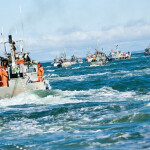Stuck at around 16 pounds since peaking at 16.6 pounds in 2004 and hitting an eight-year low of 15.8 pounds in 2010, U.S. per-capita seafood consumption is in a rut.
The reasons why are numerous: Many Americans are unfamiliar with or wary of fish and stick with beef, pork and poultry. There’s a lot of misinformation about seafood. There’s the perception that seafood costs more than competing proteins. Americans aren’t dining out as often due to the economic climate, so they’re eating less fish (about two-thirds of seafood is consumed away from home). Access to supply is increasingly challenging, as Asian consumers become wealthier and eat more fish. Fluctuating currencies and a weakening U.S. dollar are making it more difficult for U.S. supplier to access supply. The list goes on and on.
But it’s the first reason — the unfamiliarity and the wariness — that has U.S. seafood professionals continually grinding their teeth. That’s because this is a seemingly preventable obstacle, yet educating Americans about seafood — from preparations methods to health attributes — is no simple feat.
As part of the conference program at next month’s International Boston Seafood Show, I’m moderating a discussion titled “Stuck at 16: Persuading Americans to Eat More Fish.” During this free 90-minute discussion, the results of a SeafoodSource consumer survey on Americans’ finfish-purchasing behaviors at the retail level will be summarized, springboarding into a much larger discussion on educating consumers.
Among the discussion’s panelists is Roy Palmer, an all-around seafood guru who has worn a lot of hats for Australia’s seafood industry over the years. (Palmer is also a SeafoodSource blogger.) Consumer education is one of Palmer’s passions. So I asked him about the similarities between the Australian seafood market and the U.S. seafood market and about how monumental of a task educating consumers about seafood is.
Editor’s note: I hope to see you at the “Stuck at 16” discussion, which takes place at the Boston Convention and Exhibition Center on 12 March from 10:30 a.m. to 12:00 p.m. Click here for a schedule of the conference program.
Hedlund: The Australian seafood market appears to be similar to the U.S. seafood market in that it’s a struggle persuading consumers to eat more fish. Why is that?
Palmer: Australian seafood consumption is hovering around 17 kilograms (about 37 pounds), so we are ahead of the United States and we are about world average. But, as all our major cities are based on the coasts, you would assume we would have higher seafood consumption.
When Australia was “discovered,” the whole emphasis was on land food production and the introduction of many hoofed animals. The ocean was not top of mind for food production. So the country grew up on red meat for its protein. Farmers have over the years become politicians, and its human nature to concentrate on what you know.
As a result, we need to change the whole paradigm of thinking about our food production.
Price, of course, is a big obstacle. But it appears that Americans are beginning to realize that seafood really isn’t much more expensive than beef. Is this the case with Australians?
Yes. Australia exports the majority of its red meat, so prices fluctuate on local market. I do think we could learn much from Japan (sushi and sashimi) and Spain (tapas) when it comes to serving seafood. In Australia, like in the United States and Europe, we tend to want more on our plate than we need. If we could educate people and the industry about this, I believe we could increase consumption, cut down on waste and make eating seafood more affordable.
Globally, misinformation about seafood is a big problem. Where is the misinformation originating from, and is the industry beginning to chip away at the problem and work toward a solution?
Fishing has been a secretive business — fishermen did not want to let others know where they were going. This has flowed through to associations, which effectively were gatekeeping rather than communicating. Generally, fishermen want to go fishing and not deal with consumer issues. So if you wanted to know something, you needed to seek the answers out yourself. We only have ourselves to blame.
There are now some positive campaigns happening. But the difficulty is once people have an idea in their head about something, it takes a massive effort to change that.
I am a believer in that we need to address all industry issues by applying standards. You get rid of the people and organizations that simply think short term and are not prepared to follow the standards. And then you promote what no other protein food has — the health connections, which are amazing. We need to concentrate our marketing to young women and children, as they will become the drivers of demand as we move forward.
I believe there needs to be a global strategy which in effect we have the beginnings of with the Joint FAO/WHO Expert Consultation on the Risks and Benefits of Fish Consumption. The recommendations from this report should be a major part of every countries’ national strategy. I am encouraged by the work of the universities behind the GILLS program and urge others to support the aims of this website in passing on relevant information regarding seafood and health issues.
When it comes to educating consumers about seafood, where are retailers missing the boat?
Retailers in Australia do not train their counter staff in understanding seafood and how to pass on tips and relevant information to their clients. If you fail to educate your own people, how can you educate your clients? I doubt whether one person in large supermarket chains in Australia has any seafood qualification. I wonder what other industries tolerate this. Does it show that seafood is just another commodity, another product on the shelf, to these retailers?
Alaska salmon processors’ decision to pass on Marine Stewardship Council recertification has created a lot of buzz in the industry and among the trade press. Can this decision be good for the industry?
This is good for the industry, and it is good for the consumers and the country at large. The reason is that sustainability is not owned by one organization.
Sustainability is not just about the environment — it has other attributes such as economic and social issues to contend with and it is all about harvesting responsibly. Governments, generally, were slack when this whole issue was brought to the world’s attention, so good on those groups in getting some activities moving. However, now is the time for them to show us what their exit strategy is all about now that viable acceptable alternatives are available.
People have to wake up to this issue. Do they want their oceans governed by people that they democratically elect or do they want to pass this over to faceless charitable organizations that operate internationally?
Food safety is managed by governments, and the same should apply to sustainability.





